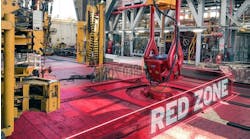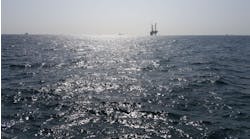Use of FEA to evaluate effects of platform explosions
Reducing shutdown time for retrofit
P.H.L. Groenenboom
P. J. van der Weijde
Engineering Systems International
- A finite element analysis was conducted on the Beryl Bravo platform to determine blast effects on surrounding modules. [6,296 bytes]
- FEA details of the Beryl Brovo deck [7,319 bytes]
- FEA details of the Beryl Brovo structure [7,498 bytes]
- The plastic hinge connection - blast wall to deck [5,351 bytes]
- Deformations on a vertical support beam [4,951 bytes]
Strengthening the wall using conventional structural steelwork would have required an extended shutdown while the welding was performed. An alternate means of strengthening using carbon fiber reinforcement was a potential means of performing the required upgrade without the requirement to shut down, as the use of the carbon fiber does not require "hot" work.
The effectiveness of the carbon fiber reinforcement needed to be demonstrated by numerical means combined with explosion tests on a test panel. Dynamic analysis with an explicit code that could take into account the nonlinear effects in the composite and strain rate and strain hardening effects in the steelwork was used to demonstrate the effectiveness of the proposed strengthening method.
Beryl Bravo structure
The Beryl Bravo platform is located in the United Kingdom sector of the northern North Sea and includes drilling, process, compression, utilities and accommodation facilities. The unit is operated by Mobil North Sea on behalf of joint venture partners Amerada Hess, BG North Sea Holdings, Enterprise Oil, and OMV (UK).The platform consists of a semi-integrated deck structure on a conventional eight-leg steel jacket. The deck structure is divided into six separate areas on two levels, divided by steel walls. The eastern end of the platform comprises the process area with the compression area above it. The accommodation is located on top of the deck at the west end and the drilling rig and drilling facilities are located on the upper deck in the center and at the east end.
Since the disaster on the Piper Alpha platform in the North Sea in 1988, which claimed the lives of 165 people, legislation in the United Kingdom has required the operators of offshore installations to produce a safety case for each installation, which demonstrates that the methods of working and the operation of the installation reduce the risk of explosion and fire damage to a level that is as low as reasonably practicable.
The safety case for the Beryl Bravo platform identified possible explosion scenarios in the process and compression areas of the platform. The original design of the platform considered the two 40-meter long by eight-meter high walls that separate the process and compression areas from the rest of the platform being required to act as fire barriers with no specific explosion requirement.
Previous studies using implicit codes had indicated that the walls would fail when subjected to a static load equivalent to the maximum overpressure from the potential explosion. It was realized, however, that numerical simulation of the wall using an implicit finite element code does not take into account the dynamic effects such as inertia related to the duration of the blast, non-uniformity of the instantaneous loading, material hardening due to strain rate effects and the energy absorbed by the plasticity.
Explosion simulation
ESI B.V., Krimpen aan den IJssel, The Netherlands, was asked to simulate the explosion conditions using the explicit finite element code Pam-Crash. This application-specific industrial software was developed for as-built and as-tested simulation of mechanical structure and has been validated by industry worldwide through simulation of full scale experiments in the automotive, railroad, and aerospace industries. By drastically reducing the number of physical prototypes that need to be built and tested, Pam-Crash can produce realistic physics-based simulations for vehicle design and reduce the design time cycle.Due to the dimensions and complexity of the platform, it was not practical to perform an explicit analysis of the complete structure. The computation and modeling effort would have been excessive. Modelers decided that the area where the potential explosion could take place would be modeled, together with an area of the platform, which would ensure that the boundary conditions applied to the model would be in the elastic regime.
To ensure that the areas of the platform that were not modeled would not affect the response, a modal analysis was performed by Mobil using an implicit finite element code, subjecting the whole structure to the blast loading to determine the boundary conditions that should be applied to the explicit analysis model.
The parts of the structure included in the model consist of the protective walls and support structure, the main plate girders, three levels of deck, together with the associated plate and secondary support beams and the platform legs between the decks. The plate girders were modeled entirely as shell elements with the meshing determined by details such as web penetrations, connections to support columns, attachments to secondary steelwork, material thickness and material type.
The majority of the secondary steelwork was modeled using shell elements to represent the webs of beams and beam elements to represent the flanges. The deck plating, the plating of the protective walls, and the wall support columns were modeled using shell elements.
Two different types of steel occur in the area of the model: a construction steel (Grade 43) for the deck and wall plates, and a high yield steel (Grade 50) for the remainder. The Grade 43 steel has an elastic modulus of 205,000 Mpa and a static yield strength of 280 N/sq mm. The Grade 50 steel has an elastic modulus of 205,000 Mpa and a static yield strength of 355 N/sq mm. Both steels were modeled
as elastoplastic with strain rate hardening, according to the Cowper-Symonds yield model. Failure criteria were adopted for the steel in the areas where potential damage could occur.
Structural loadings
Prior to the explosion load occurring on the structure, the structure is stressed due to the weight of the equipment and the weight of the structure. The loadings from Mobil's implicit analysis model were used as the basis for applying the dead and operational loadings. These loads were converted to masses and applied dynamically to the model.The walls were excluded from this part of the analysis, with weight of the walls being applied as nodal loads. This resulted in considerable savings in computational time, as the simulation time must be sufficient to produce equilibrium between the gravitational loads and the internal stresses. The presence of small finite elements within the wall modeling has a significant effect on the time steps used by the analysis code. It was necessary to redistribute some of the larger loads on the structure to produce more realistic results.
The loading was applied to the model using a gravitational field applied smoothly. The static displacement at the boundaries of the model had to be reached with a rate corresponding to the velocity of the surrounding nodes generated by the gravitational acceleration to avoid temporary stresses that might produce plasticity.
When the maximum deflections have occurred and the primary vibration frequencies can be estimated, nodal damping to these vibrations was applied. When the nodal velocities were small compared to the maximum velocities reached in the earlier part of the analysis, it could be verified that an equilibrium condition had been reached by removing the damping.
A numerical simulation of the overpressures that would occur in the event of an explosion was performed by Mobil Research and Development using the Flacs program for computation of reactive fluid dynamics. The overpressures on a one meter sq grid were obtained for the floors, roofs and walls of the modules. The assignment of the pressure time histories to the individual elements of the model was made using a Fortran routine written for this purpose.
Program run
On completion of the initial runs to derive the existing stresses prior to the explosion, the walls were added to the model and the explosion loading applied. This was achieved using the re-zone facility in the explicit code, which permits the addition or removal of elements to the model.The boundary conditions used for this part of the analysis were derived from an implicit FEA of the complete Beryl Bravo model, which included the jacket, deck and flare boom. The complete explicit model of the three decks and walls consists of 50,000 structural elements, and for an elapsed time of 250 ms the analysis took about 74 hours on a Silicon Graphics R4000 workstation.
A representative part of the blast wall was modeled with nine layers of carbon fiber on the outer flange of the support columns. The total thickness of the carbon fiber was 25 mm. ESI's bi-phase orthotropic model was used to represent the behavior of the composite section of carbon fiber and matrix material under elastic and non- linear conditions. This allows the propagation of any damage to the carbon fiber to be represented.
A representative blast load was applied to the model to provide realistic behavior of the composite under dynamic load conditions. This numerical test indicated that the carbon fiber would considerably reduce the deformation of the support columns and that no severe damage would occur to the fibers or the steel support columns.
The study concluded that:
- Inertia effects are not important when considering the individual panels of the blast wall, but are important when considering the support columns.
- Strain hardening and strain rate effects play a significant role in the behavior of the wall.
- Fluid structure interaction does not significantly affect the behavior of the wall.
Acknowledgement:
ESI B.V. wishes to thank P. Jay Consultants (Aberdeen) with whom they worked to analyze the blast walls of the Beryl Bravo Platform, and Mobil North Sea Limited for permission to publish the results.Authors:
Paul Groenenboom holds a PhD. in theoretical nuclear physics from the Free University of Amsterdam. He has 15 years experience in development in computational methods and application of numerical simulation of highly dynamic phenomena, many involving safety issues. He joined ESI in 1992 as a senior physicist where he has been involved in occupant safety during car crash studies and gas explosions on offshore platforms.Pieter van der Weijde holds a degree in civil engineering from the Polytechnic in Rotterdam. He is the managing director of ESI BV. Previously, he was employed at the Delft Hydraulics Laboratory, where he served as technical assistant of hydraulic machinery and mathematical models, project engineer of hydraulic analysis for pipeline systems (shock wave simulations), and product manager for industrial hydrodynamics.
Copyright 1997 Oil & Gas Journal. All Rights Reserved.


